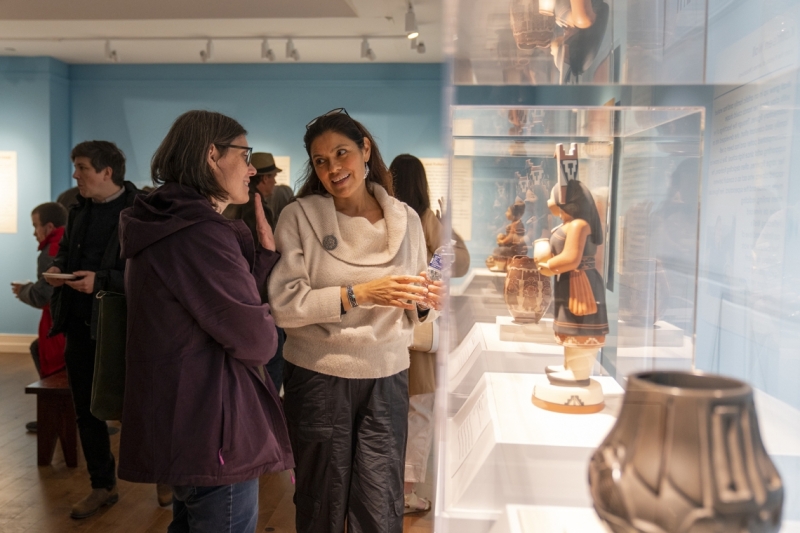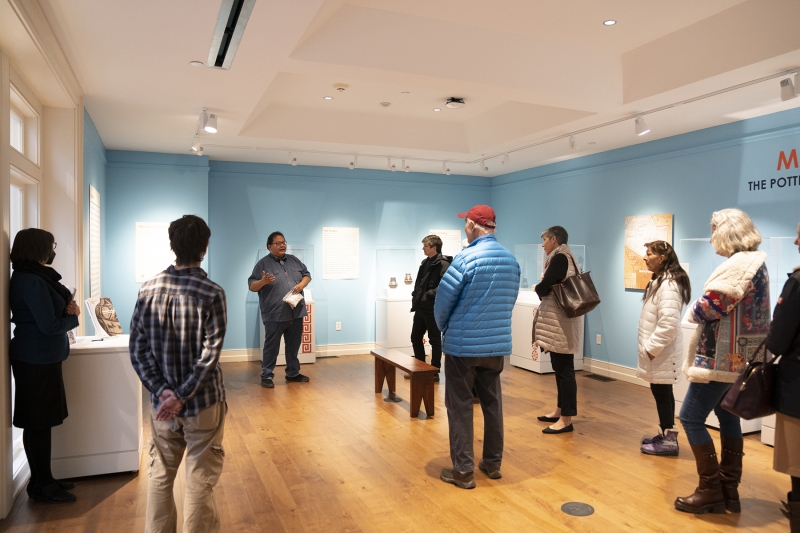Museums at W&L Expands Its Collection W&L’s most recent museum exhibition, “Mother Clay: The Pottery of Three Pueblo Women,” brought new artists into the university’s collection and connected the campus community in unexpected ways.
“Mother Clay highlights our strategic effort to present high-quality exhibitions and programs that demonstrate relevance and support our community’s pedagogical and cultural needs.”
~Isra El-beshir, director of Museums at W&L
The “Mother Clay: The Pottery of Three Pueblo Women” exhibition recently provided the Museums at W&L the opportunity to expand the diversity of its ceramics collection to incorporate its first pieces by Native American female artists. Four pieces of ceramics by Judy Tafoya, Kathleen Wall and Jody Naranjo were purchased from the exhibition, which will remain on display in the Elisabeth S. Gottwald Gallery of the Reeves Museum of Ceramics until April 29.
“Mother Clay highlights our strategic effort to present high-quality exhibitions and programs that demonstrate relevance and support our community’s pedagogical and cultural needs,” said Isra El-beshir, director of Museums at W&L. “We are committed to actively redressing inequities in our collection, particularly by focusing on women and traditionally underrepresented artists.”
“These acquisitions are important on a number of levels,” said Elizabeth Spear, Museums at W&L curator of academic engagement. “They are the first objects — ceramics or otherwise — by Native women artists to enter our collections, as well as the first examples of ceramics from any Native tradition, so even this small number of objects immediately changes our collection in an exciting way. For any student or visitor who is interested in the global history of ceramics and clay, this allows us to tell a more comprehensive — and contemporary — story.”
Kathleen Wall’s storyteller figures presented a unique opportunity for students in Professor Andrea Lepage’s Art History 395 class, a senior capstone and methodological course, to participate in a museum acquisition process. Wall visited Lepage’s class via Zoom to discuss the importance of the matrilineal passage of clay traditions and knowledge in Native American pottery. Students reviewed Wall’s three objects, selected the figure “Peaceful Presence: Hopi Maiden with Clay Pots,” and submitted an acquisition proposal with the help of Ron Fuchs, former senior curator of ceramics, to the University’s Museum Advisory Committee for consideration.
“The students were eager to get a sense of which factors play into a typical acquisitions decision — for example, cost versus artistic merit,” Spear said. “They asked questions about Kathleen’s artistic process, her biography, and what each of the three artworks represented for her personally. I was surprised and impressed with how deliberative — and how democratic — they were.”
“The students were really focused on which object could tell multiple stories, and really interested in what didactic and educational stories could be told,” Lepage said. “They picked the object thinking about which one could tell the story of women and artistic production in the context of Pueblo communities and the story of their relationships to other communities around them.”
“We spent a lot of time in the Kamen Gallery looking at how these pieces would converse with each other and how it would be possible to tell different narratives by acquiring these pieces,” said Ava Boussy ’23.
The Kamen collection, donated by alumnus Stanley A. Kamen ’40, includes over 50 paintings, prints and sculptures by primarily mid-20th century artists who worked in the American West, including three male native artists, and is now on permanent exhibition in the Lenfest Center for the Performing Arts.
“Wall’s piece strengthens our permanent collection in terms of increasing diverse voices and perspectives,” Fuchs said. “The work also adds value to the collection in terms of its potential to make significant formal and educational impacts.”
Ellie Penner ’23, a politics and art history double major with a minor in poverty studies, said the course was a rare opportunity to positively impact future classes.
“It was fascinating to engage with a narrative involving the active artistic economy within the Pueblos in New Mexico,” Penner said.
“We love the fact that students directly contributed to this decision,” Spear said. “Although this is not the first time students have been involved in an acquisition, it is certainly something we want to continue.”
The acquisition proposal project in Lepage’s class was not the only opportunity for connection and collaboration created through this exhibition.
Celeste Alvarez, vice president of W&L’s Native American Student Organization (NASO), said that the exhibition was a valuable opportunity to bring three distinct styles of Pueblo indigenous art to campus, as well as to connect students with the artists and the exhibition’s curator, Tony Chavarria. Chavarria has served as a community liaison and co-curator for the inaugural Pueblo exhibition at the National Museum of the American Indian and was co-curator for the first Native exhibition at Epcot Center.
The programming schedule also included a luncheon discussion on native allyship, hosted by alumnus Joel Bernstein ’57. Bernstein, who was instrumental in bringing an exhibition of Pueblo pottery to campus in 2017 and has been a longtime supporter of Native art in the American Southwest, said he is excited to play a role in bringing contemporary Native American artists to W&L’s campus and continuing these conversations on campus.
“One could offer an exhibition like this every year, far into the future and never run out of new, contemporary Native artists to feature,” Bernstein said.
 Kathleen Wall mingles at Mother Clay’s opening reception.
Kathleen Wall mingles at Mother Clay’s opening reception. Guest curator Tony Chavarria offers a guided tour of the exhibition.
Guest curator Tony Chavarria offers a guided tour of the exhibition.
You must be logged in to post a comment.